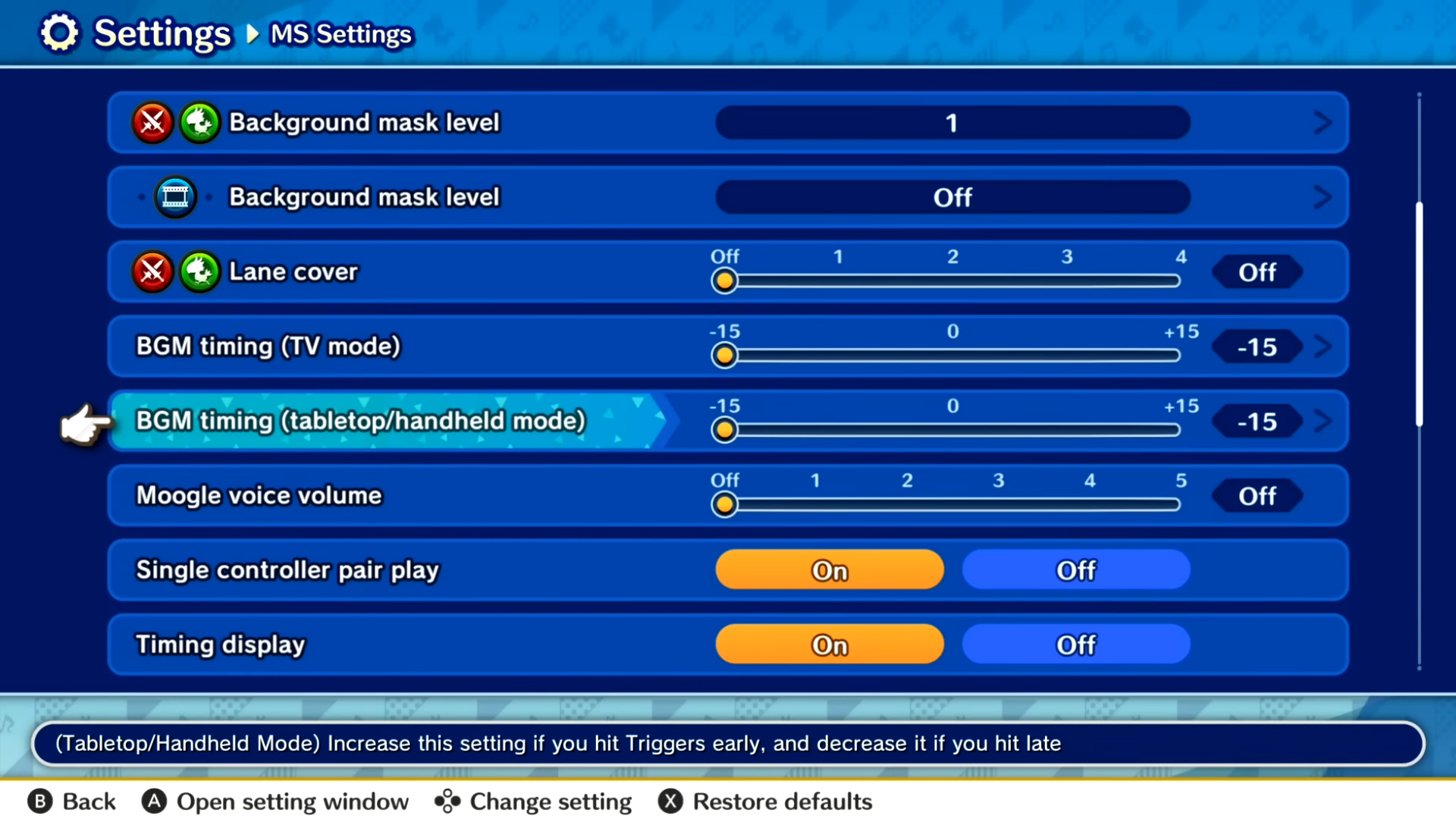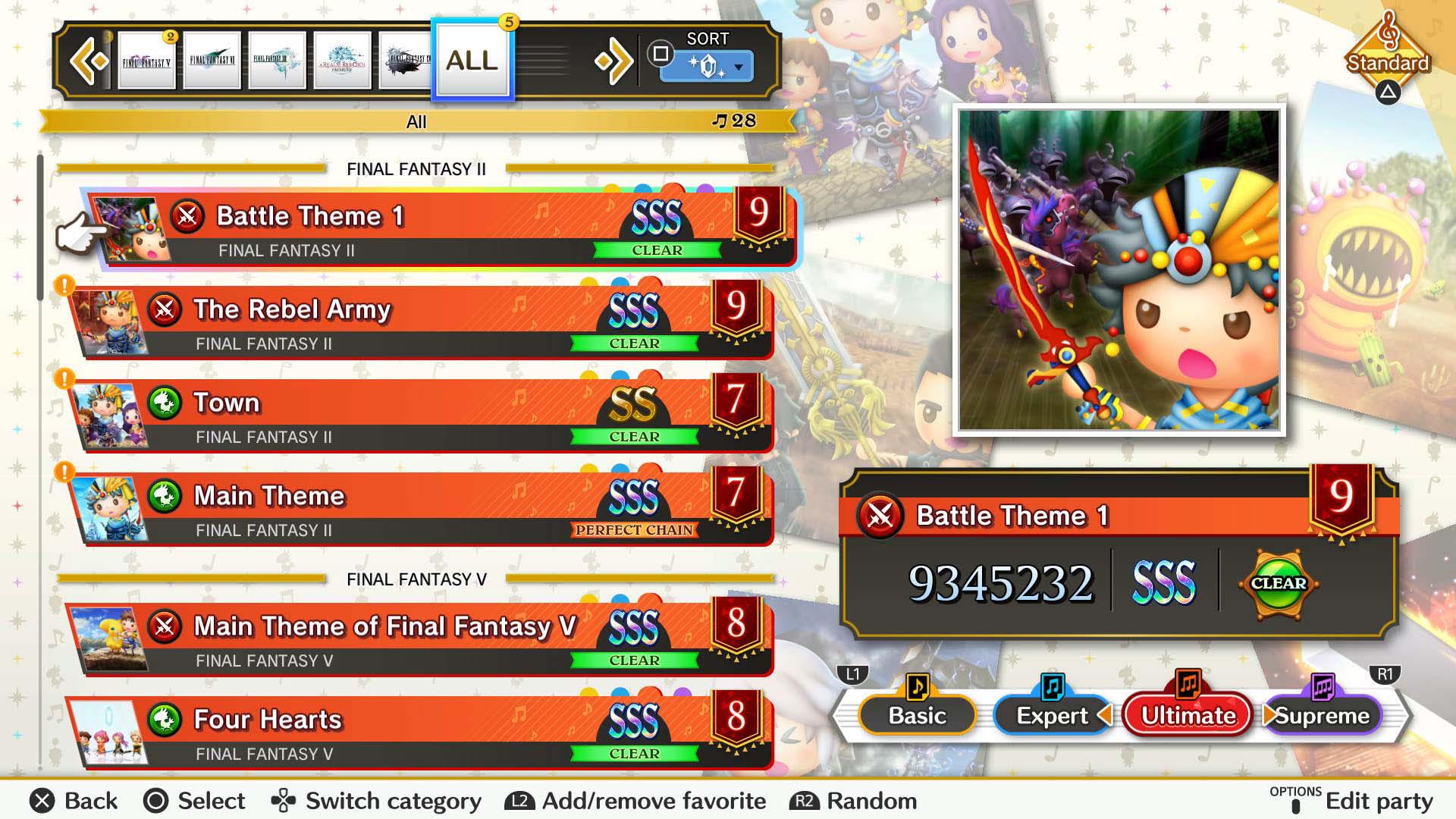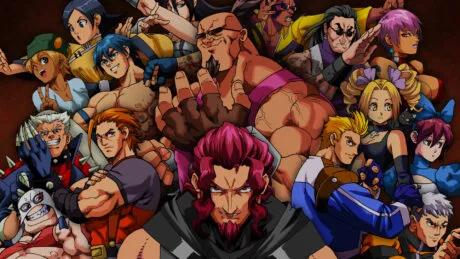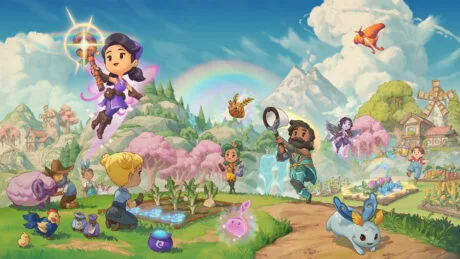Purrr....
- Solid tracklist
- Replay value
- Improved ways to play
Hisss!
- No cross play
- Calibration improvements
Platform
Switch, PlayStation 4Publisher
Square EnixDeveloper
indieszeroSeries
TheatrhythmGenre
MusicPlayers
1-2 (2-8 online)File Size (Minimum)
6.9 GBRelease Date (NA)
Feb 16, 2023Release Date (JP)
Feb 16, 2023Filed Under
Theatrhythm Final Bar Line is the latest entry in the Theatrhythm series and a solid title to celebrate 35 years of the Final Fantasy series. Releasing on both the Nintendo Switch and PlayStation 4, the game misses out on a couple features that prevents it from being a perfect performance. However, it’s still a worthy title for both Final Fantasy and rhythm fans to pick up.
A Rhythmical History

Since its debut in 2012, the Theatrhythm series has been a relatively new type of genre for Square Enix. It first appeared on the Nintendo 3DS (later on iOS) as Theatrhythm Final Fantasy. It later had a sequel in 2014 for the Nintendo 3DS, Theatrhythm Final Fantasy Curtain Call, which featured additional tracks and music from other Square Enix games. Dragon Quest, another popular role-playing game (RPG) received its own Theatrhythm title, Theatrhythm Dragon Quest, for the Nintendo 3DS in 2015. Sadly, this game never came overseas. Still, all the 3DS titles brought joy to fans of video game music.
The following year, a new Theatrhythm was released only in Japan’s arcades, Theatrhythm Final Fantasy All-Star Carnival. This title brought a new set of features that were used for Theatrhythm Final Bar Line. For example, instead of touch controls, players use buttons and joysticks. There’s no double-screen setup like the Nintendo 3DS; everything is focused on a single screen. This new setup was brought over to Theatrhythm Final Bar Line, and it’s refreshing when compared to the early entries.
New Ways to Perform

As mentioned earlier, Theatrhythm Final Bar Line uses the setup first featured in Theatrhythm Final Fantasy All-Star Carnival. However, the basic Theatrhythm gameplay remains intact. While playing, different colored circles, known as “Triggers”, will move across the screen. Each color trigger has a different input, and players have to initiate them when they overlap white circles, known as “Trigger Marks”, located on the right of the screen. When these triggers overlap the trigger marks, players must initiate them with a well-timed command using the button and/or stick. Doing so results in a score and a label: Miss, Bad, Good, Great, Critical, and a rainbow-colored Critical. The better you time your attacks, the better the score.
One of the new features from All-Star Carnival is the double-trigger. When there are two red/green circles or double arrows on a yellow circle, players need to initiate them at the same time. It adds more complexity to the gameplay but it’s enjoyable when done right.
Final Bar Line lets you play in different styles: Standard, Simple, and Pair. Standard Style is your default, single-player gameplay for hitting Triggers. The Simple Style is a pared down version of Standard, where players can use one button to play instead of multiple ones. Pair Style is a co-op mode where the Trigger Marks are paired in two. One player tackles the top two, while the other does the bottom set.
Players can challenge themselves with various difficulties: Basic, Expert, Ultimate, and Supreme. Each one increases in difficulty by adding additional Triggers. Some tracks are mind-blowing when it comes to how many Triggers fly across the screen in such a short time frame. If you’re clearing Basic difficulty with constant perfects, it’s a good idea to boost to the next level. If it gets too overwhelming, the game offers help by offering practice modes.
Additionally, the rhythm game offers online play where you can join, play against, or just watch others play. It’s an interesting feature, but it only lets players play with those with the same console version. The cross play feature to let PlayStation and Switch players play together isn’t available in Theatrhythm Final Bar Line. It’s a missed opportunity as finding online rooms has been unfulfilling for those looking for specific play levels. For this instance, newcomers will find rooms that are set for harder difficulties instead of easier stages.
Stage Performance

Compared to the original 3DS Theatrhythm titles, Final Bar Line adds more depth to its rhythm gameplay. To unlock songs to play in the game’s “Music Stages”, players will have to go through the “Series Quests” and play each song per series. It’s a chore, but it pushes players to try every series from the Final Fantasy franchise. Purchased tracks automatically are available in the Music Stages and do not need to be unlocked.
Quests feel more important than before. Collecting cards, stat-boost items, and more can be collected by completing specific requirements per song in the Series Quests. Some are simple enough to earn, like having specific characters in your party. However, there are some challenging ones, such as clearing songs at a certain difficulty or defeating a boss within 25 seconds.
Like its predecessors, Final Bar Line has three types of stages to play: Battle Music Stages (BMSs), Field Music Stages (FMSs) and Event Music Stages (EMSs). BMSs focus on combat attacks with four Trigger Marks. A FMS is an exploration where you travel between battles and use one Trigger Mark. EMSs are speciality stages that play videos in the background as you initiate triggers on four Trigger Marks, located horizontally at the bottom of the screen. Think of rhythm games like Guitar Hero where notes come down the screen.
There’s a limit on how long you can play. If you miss too many notes, your health gauge will deplete and when you run out, it’s game over. You can prevent this and clear the song if you equip healing items or have a party member with healing abilities.
More Visual Than Beats

Aside from cross play, the other gripe players may have is that Theatrhythm Final Bar Line relies heavily on visuals than the actual beat of the music. For instance, you’ll rely on your eyes to watch the Triggers closely to overlap the Trigger Marks than listening to the music itself. Thanks to YouTuber PotatoHandle for explaining this in detail (furthermore) and visually, players who have some background in playing musical instruments or heavily into rhythm games will notice this right away. There is a way to adjust this by going to the game’s settings and modify the BGM Timing. However, it doesn’t seem quite enough. The original 3DS titles feel more aligned with the audio beats than the latest Theatrhythm.
Switch players playing on handheld mode will get a closer experience with less calibration is needed when compared to playing on a television screen. The PlayStation 4 version is the same way when playing on a television set. A future patch to adjust the timing passed the -15 mark should technically solve most of the calibration issues. Hopefully the development team behind the game can make that happen. Otherwise, it’s still a fun, enjoyable title.
Build Your Team

While creating your favorite party isn’t anything new in Theatrhythm, Final Bar Line makes some modifications in this area. Characters have a specific type based on their skill set: Physical, Defense, Healing, Hunter, Summon, Support, and Magic.
You can build your team however you like. If you want a team of just Healing Types, go for it. However, to complete certain quests you’ll need a variety of types. For example, if you are looking to complete a quest that requires you to clear the song in Ultimate mode, you’ll want to add at least a healer to your party to help prevent your health bar from draining too fast when missing or hitting bad notes. For a FMS, you’ll want a team that can boost running and find treasures easily.
When you level up, so do your stats. In addition, the game offers item boosts to increase specific stats such as strength and luck. It’s noticeable when beefing up your party. If you’re looking to defeat bosses in 25 seconds, include in your team powered-up characters with unique skill sets equipped.
Summoning beasts such as Ifrit, Shiva, or Knights of the Round are equipped as one per team and not individually for each character. Instead of hitting chrome-rimmed Triggers to summon in previous titles, you just need to fill the summon gauge bar by hitting enough Triggers.
A Vibrant, Wonderful Album

Final Bar Line doesn’t hold back on its tracklist. The game offers 385 tracks to start and more if you purchase the downloadable content (DLC) packages. Tracks from non-Final Fantasy titles like Chrono Trigger, NieR: Automata, The World Ends With You and more will make their debut in this latest Theatrhythm title but with a price tag of up to $99 (USD). Those who grew up with many of these classics will splurge to play them. Players don’t have to purchase the entire package. Specific game tracks are available to purchase as smaller packages. Otherwise, the basic package of the game is already well worth playing.
In terms of visuals, the art style still resembles that of previous Theatrhythm titles with its simplistic shapes and animations. Originally, the style represented the avatars from Final Fantasy Airborne Brigade, a social mobile game that only lasted for a couple years. Some like the style; some don’t. Either way, it’s not going to be your main focus. Besides, with the fun harmonic gameplay, the game doesn’t need an overly detailed visual style.
Admittedly, the constant background movements—from your party, from enemies, and from summons—can be distracting. The game offers options to tone-down the animations and darken the background, so you can stay focused on your Triggers. Additionally, the game lets you adjust the timing of your Triggers. If you are someone that likes to initiate Triggers early, you can adjust that timing to your liking.
Whether you are playing for quests, trying out the new DLC tracks, with a partner or against three online, you’ll find yourself playing for hours. Don’t be surprised if you find yourself coming back to finish those quests the following day. Just one more song will turn into twenty more in a flash.
Performance: Switch or PlayStation 4?

Which console is best suited for Theatrhythm Final Bar Line? There’s hardly any difference in performance between the two console versions, aside from the calibration differences as mentioned earlier. If you had to ask which loads faster, playing the game on the PlayStation 5 would run better, for obvious reasons being a much more powerful console. The ability to play the game on the Switch’s handheld mode is great if you are used to playing the original 3DS titles, minus the lack of touch-screen capabilities.
However, playing the game on a bigger screen feels more relaxed and better for the eyes. Also, finding online rooms is easier on the Nintendo Switch than on the PlayStation 4. While the game hands out awards of accomplishments, it’s only for your personal view on the Switch. PlayStation users can boast about their accomplishments more publically with the game’s trophy system.
If there were any upgrades the rhythm game could use for each console, it would be these: a touch-screen mode for the Nintendo Switch, and haptics and adaptive triggers for those playing on the PlayStation 5’s DualSense controller.
The Final Performance
Theatrhythm Final Bar Line is a solid performance that fans can enjoy despite the lack of cross play capabilities and additional calibration. With an incredible tracklist of 385 songs and counting, you can’t go wrong with this title. Pick up your baton and get ready for hours of fun.
A Nintendo Switch review code provided by the publisher and a purchased digital PlayStation 4 version were used for this review.







